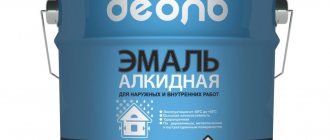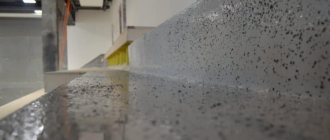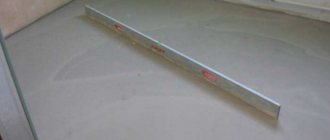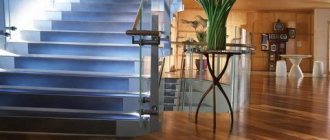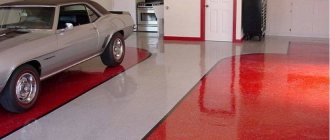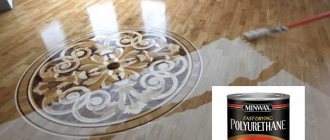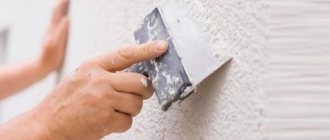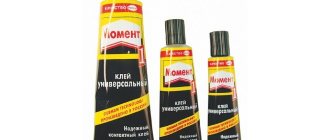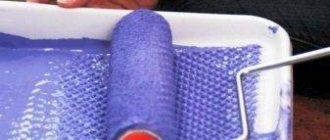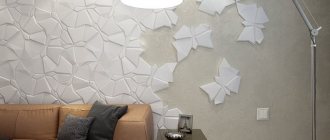Smooth, beautifully painted paths, cascades and steps are an impressive addition to a summer cottage. You can learn a lot of useful information from professionals about how to paint a concrete floor outside and how to improve paving slabs. Specialized compounds for cemented areas of the yard will help preserve the surface from destructive factors, significantly improving the appearance of a cozy yard.
Features of concrete pavement on the street
When deciding how to paint a concrete floor outdoors, it is important to take into account its specifics. Cement coating is considered universal - it is used to make floors, foundations, tiles for garden paths, and pour open areas. However, it is necessary to use additional surface treatment due to questionable aesthetics and the tendency of concrete to crack under heavy operating load.
Concrete floors are made indoors and outdoors, in workshops and various types of auxiliary premises. Depending on the overall load and operating conditions, choose what paint to paint outdoor concrete. Today they produce special coloring compositions and façade paints and varnishes for street paths and playgrounds, which have maximum protection against destruction.
Concrete floors are made indoors and outdoors, in workshops and various types of auxiliary premises.
Work technology
Concrete paint is applied in the next step in one or two layers. Depending on the requirements for the coating, it is possible to increase the number of layers. Each layer is applied after the previous one has completely dried. If by the time you start painting you notice that the paint has become thicker, it can be diluted to a working consistency using solvents.
Two-component paints should be prepared especially carefully. They are mixed with mechanical devices, because this is the only way to achieve high-quality coating. Such compositions are diluted only in the volume that you can produce within 3 hours. This is due to the fact that after mixing the ingredients enter into a chemical reaction, and the composition gradually hardens. It is impossible to store it for a long time.
Before applying the first layer, the surface condition must be checked again and the “route of movement” must be determined. For coloring you can use different tools, namely:
- rollers;
- brushes;
- pneumatic spray guns;
- levelers.
Their condition must be checked before work begins. Using brushes, you can paint surfaces adjacent to the wall. This tool will allow you to trace pipes and other communications. It will be impossible to paint the corners with a roller, as well as with a spray gun, because the walls will be dirty, like all adjacent surfaces.
Painting concrete with your own hands begins from the far corner of the room. In this case, you need to head towards the exit. There should be no gaps, and the thickness of the applied layer will be 0.5 mm. With a roller dipped in paint, you need to go over the same place several times, pressing the tool with little force. This will ensure that the composition penetrates into all microcracks. If you notice that air bubbles have appeared on the surface, you should apply the roller again. If bubbles reappear, we can talk about a problem. This indicates that a chemical reaction is occurring, which is accompanied by the release of gases.
The technology for painting concrete must be accompanied by compliance with safety regulations. Typically, dyes contain harmful solvents, therefore, when working indoors, it is necessary to ensure effective ventilation. The master needs to work using personal protective equipment. If paint gets into your eyes or mucous membranes, they must be immediately rinsed with running water.
Is it possible to paint street concrete?
While studying the topic of how to paint a concrete floor on the street, we come to the conclusion that this is an easy way to update cemented paths and areas.
Painting can be recommended for concrete surfaces in the yard:
- Children's and sports grounds;
- Garden alleys;
- Flowerbed borders and other decor;
- Loading area in a gazebo or under a canopy.
Outdoors, concreted areas are subject to heavy loads, abrasives, mechanical shocks and wheel friction. An unprotected screed quickly loses its attractiveness; its porous base may crumble.
Outdoors, concreted areas are subject to heavy loads, abrasives, mechanical shocks and wheel friction.
Benefits of painting concrete surfaces
The porous concrete surface absorbs moisture from precipitation and watering, when washing equipment and vehicles. Painting is a real way to protect.
After a protective film, concrete floors and walkways have more advantages than a conventional concrete base:
- Film waterproofing coating – good protection against cleaning chemicals and fuels and lubricants;
- Aesthetics are improved (there is the possibility of multi-colored painting and marking of sides and garden alleys);
- Increases wear resistance and service life;
- Concrete does not generate dust (important for playgrounds);
- The process of cleaning smooth surfaces is simplified.
Correctly selected paint for concrete paths on the street additionally stops the destructive effects of weathering and temperature changes.
Correctly selected paint for concrete paths on the street additionally stops the destructive effects of weathering and temperature changes.
Cement floor protection
Cement floors are now very often installed in industrial or commercial buildings. But at the same time, they can be seen in home workshops, garages, cellars, outbuildings and storage rooms. Although concrete itself can withstand heavy loads under negative implementation criteria, it still requires protection.
Concrete is characterized by enormous porosity and a low level of tensile strength; therefore, when external causes act on its unprotected surface, it wears out, peels off, and then corresponding dust appears. This happens very often in cases of the introduction of low-quality concrete, violation of laying technology, incorrect mixing of the consistency, and the introduction of bad cement.
To protect the cement surface, it is customary to use special compounds. In addition to decorative parameters, painting a cement floor protects it from destruction, exposure to aggressive environments and abrasive wear, provides additional characteristics such as hygiene, anti-slip, decontamination, antistatic, smoothes out bulges, and masks various defects of the floor - chips, cracks, sinkholes and cavities.
Requirements for compositions
The concrete pouring has to be renewed periodically. Painting can delay the rough restoration of concrete floors and walkways. When choosing paint for concrete paths, it is recommended to evaluate the main characteristics of the composition.
The purchased coatings must meet certain requirements:
have increased resistance to abrasion;
- Be resistant to mechanical stress;
- Resistant to damage from UV rays;
- Improve the aesthetics of the surface after painting;
- Have a convenient consistency for painting with your own hands;
- Have sufficient breathability and resistance to weather factors.
Compositions for painting floors and street coverings made of cement meet these requirements, maintaining the specified characteristics for many years.
When choosing paint for concrete paths, it is recommended to evaluate the main characteristics of the composition.
Coloring compounds
Often, concrete floors and garden frames are left unpainted, given the strength of the building material. When it comes to how to paint a concrete floor on the street, various paints and varnishes are mentioned - polymer varnishes, enamels and impregnations that are suitable for cemented floors and paths.
- Impregnation. Deep penetration composition that prevents the penetration of excess moisture, dirt and oily substances into the pores of concrete. Impregnated bases are better able to withstand increased loads;
- Varnish. Specialized water-dispersion varnish for concrete floors Contains latex components, an excellent means for isolating surfaces adjacent to the floor;
- Enamel. The polymer composition is a universal option for effectively protecting floors based on cement screed. This niche offers coatings containing epoxy, polyurethane and acrylates.
Varnish without impregnation is weak protection for floors with increased load. Rather, it is the equivalent of varnish surfaces made from other building materials, a durable ennobling coating.
When it comes to how to paint a concrete floor on the street, various paints and varnishes are mentioned - polymer varnishes, enamels and impregnations that are suitable for cemented floors and paths.
Staining
A specific composition is used for wood, but there are also options for concrete to highlight fragments of paths and foundations. Stain is widely used to decorate imitation stone near the foundation or basement; floors are not painted with it.
Paintwork materials on concrete can be used for decoration:
- Garden alleys;
- External stairs;
- Cascade flower beds;
- Exterior finishing of outdoor swimming pools;
- Fences and barriers made of concrete blocks.
For external use, stains on different bases are used. Inexpensive acrylic compositions are considered the most popular. Epoxy stains have a high hydrophobic coefficient. Acidic, the most expensive, can imitate expensive varieties of stone.
A specific composition is used for wood, but there are also options for concrete to highlight fragments of paths and foundations.
Rubber paint
The so-called “rubber” paint contains latex substances. Paints and varnishes are used for external surfaces and self-leveling floors due to their unique characteristics and high aesthetics.
When mentioning how to paint a concrete path, they talk about a quick-drying emulsion. After half an hour the coating dries. Painting is possible in sunny frosty weather, but the polymerization time varies. The only drawback is the price.
The composition is applied with a roller or brush. The consistency of the dye resembles polyurethane alkyd enamel. The coating tolerates large temperature fluctuations well.
Paints and varnishes are used for external surfaces and self-leveling floors due to their unique characteristics and high aesthetics.
Epoxy and acrylic paints
Floor paints based on acrylates are what you can use to paint a concrete path on the street. These are water-soluble composite compositions with polymer inclusion. They provide a durable film that prevents corrosion and weathering of concrete.
Acrylic compositions are convenient to apply with household tools - brush, roller and spray. When painting a small area with a single layer, it is advisable to treat it with a primer. The second layer is performed after 10-12 hours.
Guests will not immediately understand that this is ordinary concrete with a paint that has high adhesion. The protective polymer composition forms a resistant film that protects against destructive processes due to mechanical and chemical influence.
When looking at the offers in a paint and varnish store, some people wonder if it is possible to paint a concrete path on the street with epoxy? Thanks to the hardening of resinous substances, paintwork materials prolong the durability of the surface. With it, country alleys and paths near the pool will have a presentable appearance.
The protective polymer composition forms a resistant film that protects against destructive processes due to mechanical and chemical influence.
Epoxy paint is not susceptible to corrosion from fuel and lubricant stains. The coating is resistant to adverse external factors and chemicals with acidic or alkaline reactions.
The dye is suitable for open areas:
- Mini parking;
- Open terrace or veranda;
- A section of the yard adjacent to the porch, characterized by a high load of shoes and children's bicycles.
The composition is resistant to atmospheric conditions, and it can be applied to fresh concrete that has not completely dried.
Paint based on epoxy resin will retain its qualities for a long time, it will not turn yellow and will retain its original color. The disadvantages of two-component dyes are mixing before application, as well as difficulties in changing the shade.
The coating is resistant to adverse external factors and chemicals with acidic or alkaline reactions.
Polyurethane varnishes
Two-component polyurethane compounds provide high quality coating. They are used for concrete floors inside work areas and for outdoor areas.
The main advantages of polyurethane dyes:
- Durability;
- Cost-effective;
- Aesthetic glossy surface;
- High resistance to atmospheric, chemical and mechanical influences.
Application is possible at low humidity and temperatures above +5°C. Warm, dry air will speed up polymerization. The main advantage is the resistance of polyurethane to stains from gasoline, diesel fuel, aggressive detergents and oily substances.
Two-component polyurethane compounds provide high quality coating.
Acrylic paints for concrete walls
Most often, acrylic compositions, which are divided into organic and water-based, are used to decorate walls (both internal and external). Solvent paints form a coating with high mechanical strength that is resistant to temperature changes, moisture and other aggressive influences.
Many of them (for example, “Akrial-Lux” from KRASKO price - 140 rubles / kg) allow work in the winter. And yet, in private homes, organic paints and varnishes are rarely used. The reason is a sharp unpleasant odor, difficulties with tinting and a relatively long drying time.
Water-soluble acrylic paints do not have all these disadvantages. But they are inferior to “organic” in terms of strength and durability of the coating. However, in suburban properties the load on the facades and internal walls of buildings is much lower than in industrial areas, so most often the owners of private houses give preference to water-soluble emulsions. They are produced by almost all large “paint” companies, both domestic and foreign. The average cost of the product at the moment is 125-200 rubles/kg.
Another option for finishing concrete walls is alkyd enamels.
Interestingly, they can be used not only on mineral, but also on metal and wooden surfaces. The paint layer adheres firmly to materials with completely different properties thanks to the binder – alkyd resin.
In air it polymerizes, forming a smooth and elastic coating with good adhesion. Alkyd compositions are extremely durable (much stronger than acrylic), but it should be noted that they are solvent-soluble. with all the ensuing consequences - unpleasant odor, long drying time, etc. The cost of products of this kind is relatively low.
For example, the price of PF-115 universal enamel from TEX in a 2.5 kg container is about 500 rubles. Alkyd enamels come in three levels of gloss: glossy, semi-gloss and matte. For outdoor work, it is reasonable to give preference to the first type - a smooth paint layer lasts on average 15-20% longer than a rough one.
Which paint is best?
Some people find it difficult to choose what to paint a concrete path in their country house or countryside. For high-quality adhesion of a concrete floor with paints on different bases, it is recommended to prime it with a primer from Grid or Beolux Aqua.
The composition for external work on reinforced concrete products should be:
- Resistant to changes in temperature and humidity;
- Sufficiently wear-resistant to abrasion;
- Eco-friendly (no pungent odor);
- Quick-drying;
- Fire resistant;
- Inert to chemicals;
- Have a smooth surface that is easy to clean.
You should not use organofluorine, alkyd and oil paints - they react with fuels and lubricants.
Modern compositions for external concrete work retain their protective properties for 10 years.
For high-quality adhesion of a concrete floor with paints on different bases, primer treatment is recommended.
Pros and cons of concrete floors
Unpainted concrete floors significantly complicate and slow down room cleaning.
The almost universal use of concrete as a floor covering is justified, since it has the following properties:
- hard, durable material:
- withstands heavy weight;
- withstands temperature changes well and is also little influenced by the external environment;
- minor mechanical damage to the surface can be quickly corrected by covering it with cement mortar;
- durable.
Among the disadvantages of a concrete floor are:
- During its operation, quite a lot of dust is generated;
- chemicals eat into the concrete.
Painting a concrete floor is one of the options that will help save the room from these negative qualities or neutralize their negative impact.
Step by step painting instructions
An important part of the process is preparation. After removing all objects from the surface, thoroughly clean oil stains and traces of dirt with a brush. Then the treated area is washed or dusted.
A protective barrier for plants is needed if a spray gun is used. Adjacent surfaces are protected from spray paint.
When cleaning playground paths, the maximum effect is achieved by washing with a pressure hose or a washing machine.
After washing, the concrete should dry for 1-2 days, depending on the weather. Afterwards, you can apply the first layer or base for the final coloring.
When cleaning playground paths, the maximum effect is achieved by washing with a pressure hose or a washing machine.
Brush painting technique
Painting the floor with a brush or brush is not very convenient, but they are needed in hard-to-reach places and on difficult surfaces. A paint brush is the best device for high-quality painting of paving slabs, borders, flower beds and sports markings. For beginners, it is recommended to apply a little paint to the remaining tiles to evaluate how the concrete is absorbed, whether the consistency and color are suitable.
On smooth areas, it is recommended to use a combined painting method - with a roller or spray, filling the cracks with a mixture of dye and sand.
The paint is distributed in strokes from top to bottom, the second layer is from right to left. The first staining will show how carefully the concrete has been processed. A second coat gives an impeccable result; it will hide bald spots and rough brush strokes.
The paint is distributed in strokes from top to bottom, the second layer is from right to left.
Subtleties of working with a paint sprayer
It is convenient to paint the floor with a spray gun. It gives an even coating, economically distributing the composition. It is advisable to fill it with water-based paint, which is easy to clean from the painting machine.
Colored areas of the sports ground are marked with a diamond cutter.
The first layer undergoes a polymerization process for about a day. Dry surfaces can be repainted.
It gives an even coating, economically distributing the composition.
Application of a roller
To paint a small area or individual stripes along the edges of a path, I use a roller with a long (telescopic) handle. It is advisable to use a medium-porous nozzle (to reduce paint consumption).
The composition is applied to a clean, dry surface. If these are tiled garden alleys, there may be bends and hard-to-reach areas - it is better to walk along them with a paint brush. The finishing layer can be replaced with clear varnish.
It is advisable to use a medium-porous nozzle.
How to paint a concrete floor?
Dust removal and priming of the concrete floor before painting
To ensure that the process of painting a concrete floor goes smoothly, you must prepare in advance:
- paint container;
- brushes for painting in hard-to-reach places;
- several rollers and a clasp (a special handle where the rollers are put);
- protective gloves, glasses;
- change of clothes;
- masking tape.
If you already have all of the above, you can proceed to a more active stage - painting the concrete floor. Conventionally, it can be divided into several stages:
- Initial or preparatory. In order for the enamel to serve for a long time and fully fulfill all the tasks assigned to it, it is necessary to ensure that the surface is clean before painting. Therefore, the first step is to thoroughly clean the room, remove all debris, sawdust, dirt, stains from old paint or other chemicals are removed with a mild detergent. Also, the main thing is not to forget to seal all the cracks and cracks with cement mortar. It is recommended to remove dust with a vacuum cleaner or just a mop. After cleaning, be sure to wait until the concrete dries. How long will you have to wait? It’s quite easy to check whether the base is ready for painting. You need to cover the floor with a piece of polyethylene, and after a day see if moisture has collected there. If it's dry, then you can start working.
- Primer. To improve the adhesion of the enamel and the concrete surface, you first need to cover the entire surface with a primer, and only then start painting. The construction supermarket has quite a large selection of this product. To treat the floor, you can use Grida and Beolux Aqua primers. How much it costs depends on the manufacturer, so the price of Tikkurila BETOLUX AKVA POHJUSTE for 5 liters is $13, and 1 kg of PS-Grunt can be purchased for $4.5. The next important question that needs to be answered is: how much primer is needed? Experienced craftsmen recommend calculating the amount of primer using the rule that per 1 sq.m. spend, as a rule, 250-500 grams. It is necessary to take into account that the topography of the floor and the grade of concrete are of great importance.
Applying paint to the surface of the base with a roller
Painting is carried out taking into account several rules:
- Painting a concrete floor should be carried out at a temperature of at least 10 degrees above zero with an air humidity of no more than 80%. The paint must be applied in at least two layers. In this case, there must be a break between work so that the first one dries well before applying the second layer. For ease of use, it is recommended to use rollers with long handles. When painting, the following nuances must be taken into account:
- The paint must be applied in different directions and then rubbed onto the surface;
- Layers of paint should not be very thick, since, firstly, the aesthetic appearance of the floor deteriorates, and secondly, the surface takes longer to dry;
- Apply a new coat of paint only after the previous one has completely dried.
After completing the work, it is necessary to let the paint dry. How long it will take depends on the type of enamel: acrylic paints dry in 12-14 hours, and polyurethane paints take the longest to dry - up to two weeks.
Review of the best paints for concrete from popular and reliable manufacturers
There are a lot of paints and varnishes on sale that can be used to quickly and efficiently paint outdoor concrete floors. Experts prefer formulations from well-known brands:
- "KrasKo";
- "Tapping";
- "Elakor";
- Tikkurila (Finland).
Durability depends on quality assurance from manufacturers, if the composition is properly selected.
Professionals use Teping P1155 (epoxy-based), Polymerstone-1 (polyurethane enamel), acrylic Betoxyl and Epostone (water-based epoxy enamel) dyes. They are of high quality.
Durability depends on quality assurance from manufacturers, if the composition is properly selected.
How to care for painted concrete outdoors
Proper care guarantees the durability of concrete paths and steps. Abrasive substances that drag on outdoor shoes are detrimental to any paint job. Dirt and sand are washed off under pressure from the hose.
Painted garden paths are cleared from rain; in between, they can be washed with a hose, wiped with a sponge, and rinsed with a watering can.
It is undesirable to repaint concrete paths with different compositions - the coating may crack. If you do not put a lot of stress on the painting, the colored paths will please the eye for a long time.
Dirt and sand are washed off under pressure from the hose.
Alternative to dyeing
Painting can be replaced by other methods of coloring and strengthening concrete:
- Self-leveling polymer flooring is an expensive option; its advantage is a self-leveling base. Recommended for a terrace, veranda or large loggia;
- Porcelain tiles and paving slabs are a popular way to improve cemented areas in the yard;
- Covering with innovative materials such as crumb rubber. A relatively soft option, used for sports fields;
- Epoxy impregnation is a budget alternative that provides waterproof protection;
- Polyurethane primer for painting, used as an independent method of preservation. The surface will be resistant to chemicals and petroleum products (important for parking a car in the yard);
- Pigments based on iron oxides – additives in dry cement, impregnations and primers. They are resistant to chemicals. The versatility of the pigment is that it is also suitable for other surfaces.
The entire list of alternative materials can be found in specialized catalogs from foreign and domestic manufacturers.
Porcelain tiles and paving slabs are a popular way to improve cemented areas in the yard.
After painting, the concrete surface takes on an aesthetic appearance. Impregnation will provide protection from minor damage and weather and climatic influences. For a long time, the surface of the paths will look like it has been recently renovated. The coating will be the least traumatic for children playing on a playground with a smooth surface.
What else can you use to cover concrete floors?
Painting is the best way to clean up the concrete floor in your home or garage when you want the job done inexpensively. This is the best option for those who want to make repairs “cheap and cheerful”. You can consider other options for protective coating for concrete:
- boards;
- tiles (ceramic, rubber or PVC);
- self-leveling mixture (so-called self-leveling floors);
- dry cement;
- polymer toppings.
The last two options, unfortunately, are only feasible at the construction stage. That is, it will not work to strengthen a concrete floor with a layer of dry cement in an already finished room. However, the remaining solutions are suitable for anyone who is faced with the problem of “dusty” concrete floors, wants to solve it once and for all and is not afraid of high repair costs.
